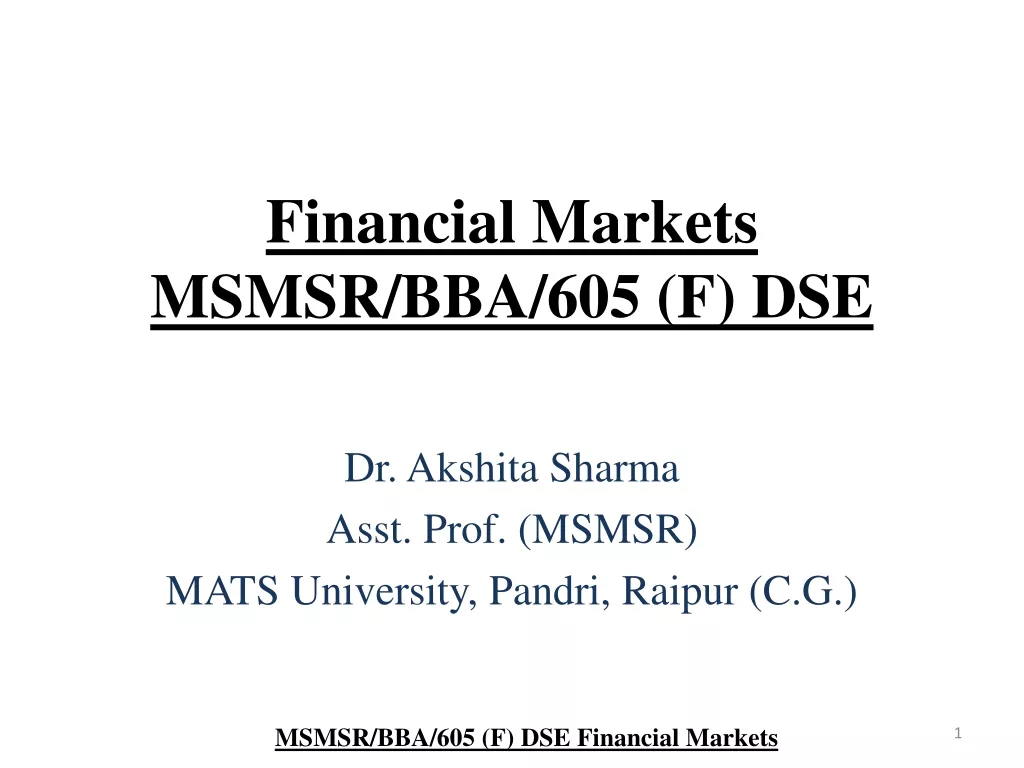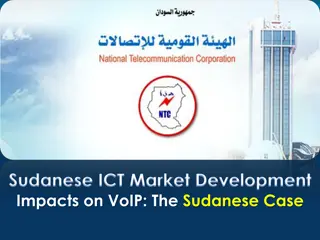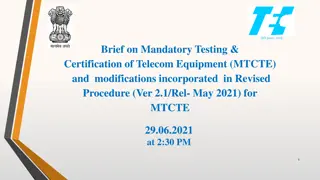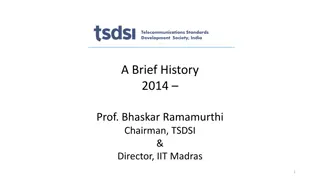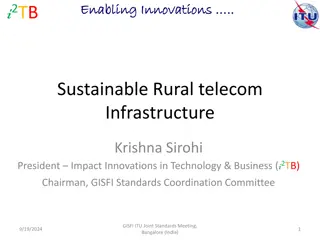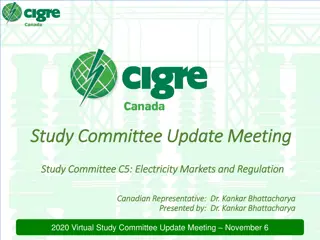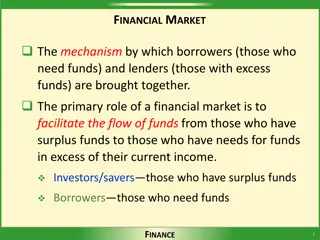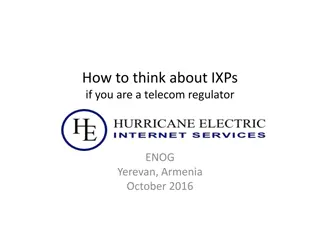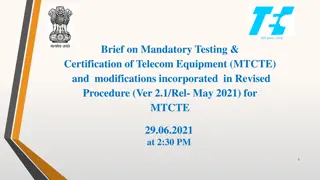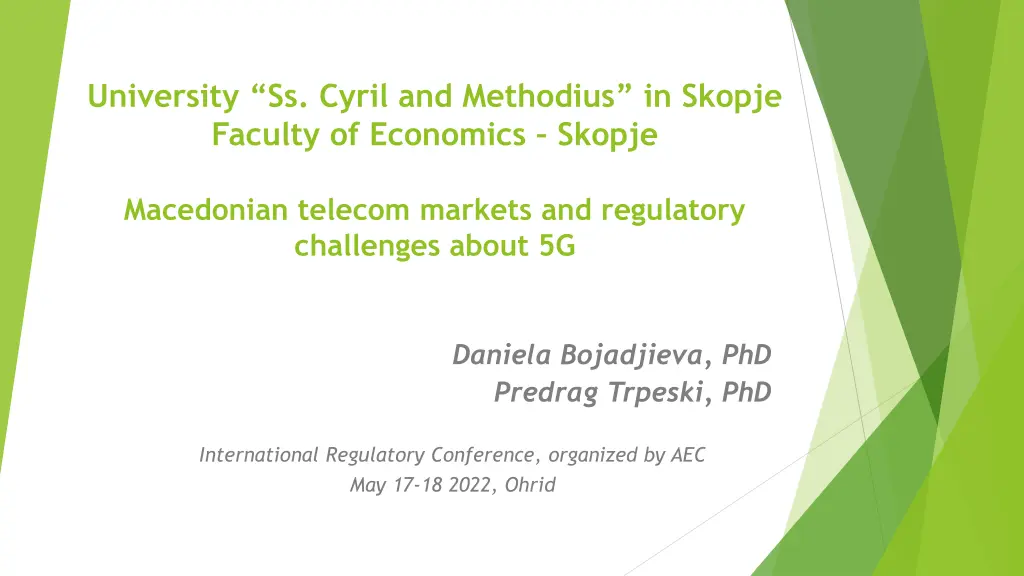
Telecom Markets and Regulatory Challenges in North Macedonia
Explore the current state and performances of Macedonian telecommunications markets, focusing on weak competition, regulatory issues, and the transition to collaborative regulation. Learn about the unique mobile market structure, fixed telephony operators, subscriber trends, and the evolution of sector regulation. Stay informed about the challenges and opportunities in the telecom sector in North Macedonia.
Download Presentation

Please find below an Image/Link to download the presentation.
The content on the website is provided AS IS for your information and personal use only. It may not be sold, licensed, or shared on other websites without obtaining consent from the author. If you encounter any issues during the download, it is possible that the publisher has removed the file from their server.
You are allowed to download the files provided on this website for personal or commercial use, subject to the condition that they are used lawfully. All files are the property of their respective owners.
The content on the website is provided AS IS for your information and personal use only. It may not be sold, licensed, or shared on other websites without obtaining consent from the author.
E N D
Presentation Transcript
University Ss. Cyril and Methodius in Skopje Faculty of Economics Skopje Macedonian telecom markets and regulatory challenges about 5G Daniela Bojadjieva, PhD Predrag Trpeski, PhD International Regulatory Conference, organized by AEC May 17-18 2022, Ohrid
Outline of the presentation Current state and performances of Macedonian telecommunication markets Weak market competition and miscoordination of ex-ante and ex-post sector regulation create a favorable business conditions for incumbent mobile network operators on the detriment of consumer welfare and public interest. Evolution of sector regulation and transition from G4 (Integrated regulation) to G5 (Collaborative regulation)
Current state and performances of Macedonian telecommunication markets Characteristics of the telecom markets: In 2015 (July) market structure has transformed from 3 to 2 operators, and Macedonian mobile markets became a unique case in Europe with only two MNOs. Market supply side participants (2020): (I) In the mobile telephony segment: Two MNOs: Makedonski Telekom-Skopje (m.s. 47.12%), and A1 Makedonija Skopje (m.s. 49.76%) (EU average level of the firm s highest market share is 35%) - Three MVNOs: Lyca Mobile - Skopje (m.s.1.99%); Robi- Shtip (m.s.1.12%); Green Mobile Prilep (m.s.0.01%) - Market structure is symmetric (dominated by MT and A1) with very high HHI values - HHI 2014 Mobile telephony 2018 2020 Total revenues 3788 4970 4874 Number of subscribers 3605 4654 4701 *source: Available data from AEK reports
Current state and performances of Macedonian telecommunication markets Characteristics of the telecom markets: (II) In the fixed telephony segment: 17 operators. This segment is dominated by Makedonski Telekom (m.s. 53.2%), and A1 Makedonija (m.s. 38.78%), then are following: Robi (m.s. 4.80%), Neotel (m.s. 2.56%) and Infel Net Plus (m.s. 065%). - After the merger between VIP and ONE (in 2015) the number of operators in fixed telephony has significantly decreased (from 33 in 2014 to 17 in 2020). - HHI 2014 Fixed telephony 2018 2020 Number of subscribers 4159 4323 4365 *source: Available data from AEK reports
Current state and performances of Macedonian telecommunication markets Number of active subscribers in the segment of mobile telephony is declining , but in the segment of fixed telephony the number of subscribers is stable with an insignificant increment. - Number subscribers (both in fixed and mobile segment) is increasing over the period 2014-2020. of active broadband -
Current state and performances of Macedonian telecommunication markets Total revenues over the period (2014- 2020), after the phase of decrement, are increasing but still are below the level of 2014. The price of services (organized in different baskets) are increasing (over the period 2014-2020). Highest price changed is noticed in the baskets for fixed-broadband and mobile- broadband baskets.
Source: ITU , prices in USD 2014 25.41 6.63 14 NA NA 17.65 13.05 19.3 NA NA 12.9 6.44 12.7 NA NA 25.21 15.92 24.1 NA NA 2015 23.46 6.54 6.7 NA NA 14.79 11.52 9.7 NA NA 10.79 5.38 10.6 NA NA 21.07 7.71 7.7 NA NA 2016 23.4 5.53 6.5 NA NA 14.9 11.61 9.8 NA NA 14.34 5.36 10.6 NA NA 33.13 7.69 4.4 NA NA 2017 31.72 5.63 6.63 NA NA 15.31 11.93 6.6 NA NA 14.62 5.47 10.73 NA NA 34.88 7.88 4.45 NA NA 2018 33.93 13.84 4.15 35.11 35.11 24.84 15.77 3.82 8.44 8.6 17.25 7.27 6.96 10.88 12.46 38.96 15.34 18.88 18.88 29.51 2019 32.95 11.81 4.25 10.72 16.63 7.77 15.77 23.73 23.73 23.73 17.25 8.62 10.88 10.88 15.33 41.33 15.34 17.7 17.7 17.7 2020 33.91 11.34 3.98 9.63 9.63 7.32 19.36 19.36 19.36 19.36 16.51 8.24 11 11 13.74 39.7 15.87 18.14 18.14 18.14 2021 33.64 12.06 4.23 10.24 10.24 7.81 8.64 7.04 7.04 8.64 17.57 9.75 11.71 11.71 15.62 43.41 13.25 20.49 20.49 20.49 Austria Austria Austria Austria Austria Croatia Croatia Croatia Croatia Croatia Macedonia Macedonia Macedonia Macedonia Macedonia Slovenia Slovenia Slovenia Slovenia Slovenia Fixed-broadband basket (5GB) Data-only mobile-broadband basket (2GB) Mobile-cellular low-usage basket (70 min + 20 SMS) Mobile data and voice low-consumption basket (70 min + 20 SMS + 500 MB) Mobile data and voice high-consumption basket (140 min + 70 SMS + 2 GB) Fixed-broadband basket (5GB) Data-only mobile-broadband basket (2GB) Mobile-cellular low-usage basket (70 min + 20 SMS) Mobile data and voice low-consumption basket (70 min + 20 SMS + 500 MB) Mobile data and voice high-consumption basket (140 min + 70 SMS + 2 GB) Fixed-broadband basket (5GB) Data-only mobile-broadband basket (2GB) Mobile-cellular low-usage basket (70 min + 20 SMS) Mobile data and voice low-consumption basket (70 min + 20 SMS + 500 MB) Mobile data and voice high-consumption basket (140 min + 70 SMS + 2 GB) Fixed-broadband basket (5GB) Data-only mobile-broadband basket (2GB) Mobile-cellular low-usage basket (70 min + 20 SMS) Mobile data and voice low-consumption basket (70 min + 20 SMS + 500 MB) Mobile data and voice high-consumption basket (140 min + 70 SMS + 2 GB)
Current state and performances of Macedonian telecommunication markets Macedonian telecommunication markets is highly concentrated, with restricted competition among incumbent firms. Using the restricted econometric models, based on the DiD approach, Bojadjieva and Trpeski (2020), depict several determinants of the firms market behavior. The number of incumbent firms is negatively - correlated with prices. (decreasing the number of competitors increases the price levels) Ex-ante regulatory pressure is more - significant for Increasing Investment activities of incumbent firms, than the higher concentration in mobile markets. The change in GDP p.c. is not significant for the - change in price levels.
Ex-ante and ex-post sector regulation Unfortunately, expectations that the merger VIP-One will lead to sizeable efficiencies which are then passed on to consumers, didn t realize. The weak competition and inadequate ex-post competition are persistent problems in Macedonian telecommunication markets. (Country Progress Reports issued by EC, and ICT Regulatory tracker). ICT Regulatory Track - 2020 Regulatory authority Regulatory mandate Regulatory regime Competition framework Overall score Macedonia 19 20 30 19 88 Slovenia 20 21 30 27 98 Croatia 19 19 28 28 94 Austria 18 16.5 28 27 89.5
Ex-ante and ex-post sector regulation Commission for Protection of Competition (CPC) has not adequate capacity and integrity to cope with the problems with restricted market competition in Macedonian telecommunication markets. How to restore the market competition? Is the implementation of 5G opening the door for new entrants? According the ICT Regulatory tracker score, Macedonia has developed integrated regulation (G4) which is led by economic and social policy goals. G5 - Collaborative regulation (or 5th generation regulation): It constitutes the gold standard for collaboration amongst regulators, and for the design of digital policy and legal instruments that maximize digital transformation. Collaborative regulation puts consumer benefits and protection in its focus and leverages the resources of government institutions and industry to deliver them, through organic consultation, collaboration and conciliation. Collaborative regulation is driven by leadership, incentive and reward rather than by command and control schemes. The concept also refers to the set of new tools used by regulators to tackle the issues related to digital transformation and the data economy. Industry and regulators charting a common future.
Conclusions The implementation of an effective regulatory framework has resulted in greater economic growth, increased investment, lower prices, better quality of service, higher penetration, and more rapid technological innovation in the sector. To transition to an effective, competitive environment, regulatory reform must include measures aimed at: (i) creating functional regulators to oversee the introduction of competition; (ii) preparing the incumbent operator to face competition (e.g., deadlines for market exclusivities); (iii) allocating and managing scarce resources in a nondiscriminatory way; (iv) expanding and enhancing access to telecommunications and ICT networks and services; and (v) promoting and protecting consumer interests, including universal access and privacy
Thank you for your attention

